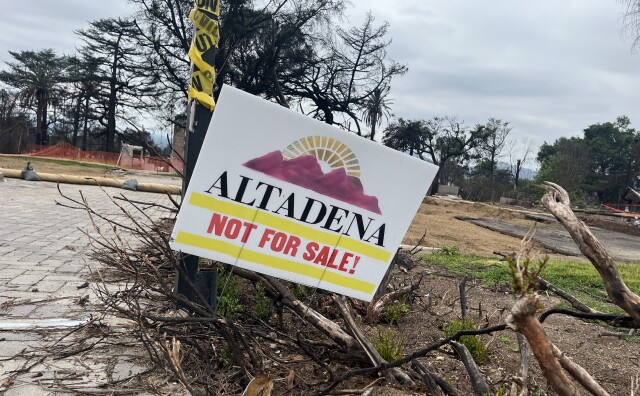Congress has cut federal funding for public media — a $3.4 million loss for LAist. We count on readers like you to protect our nonprofit newsroom. Become a monthly member and sustain local journalism.
This archival content was written, edited, and published prior to LAist's acquisition by its current owner, Southern California Public Radio ("SCPR"). Content, such as language choice and subject matter, in archival articles therefore may not align with SCPR's current editorial standards. To learn more about those standards and why we make this distinction, please click here.
Nobody Hikes in L.A.: Falls Creek Falls Is So Nice They Named It Twice

By David Lockeretz of Nobody Hikes in L.A. / Special to LAistPerhaps it’s because most people associate them with Yosemite and not Los Angeles that waterfalls tend to be among Southern California’s most popular hiking destinations. Sturtevant, Holy Jim, Eaton, Temescal and Etiwanda are just a few of the many waterfalls that lie just beyond the urban fringe of Los Angeles. However, as well known as these waterfalls may be among L.A. hikers, there are more that still flow in relative obscurity. One of these is Falls Canyon Falls, located in Big Tujunga Canyon at the western end of the San Gabriel Mountains.
While its name may be redundant, Falls Canyon Falls can be one of the most dramatic waterfalls in the San Gabriel Mountains. It cascades down a total of four tiers. Only the bottom, which is the tallest at 70 feet, is easily accessible, but on the way down, hikers are treated to a dramatic view of the entire thing. The hike from Big Tujunga Canyon Road is a moderate, four-mile plus round trip. Some off trail scrambling near the end—during which there is much poison oak to be avoided—is required, but experienced hikers will have no problem with it and even newbies who are in decent shape should be fine. This trail is similar to, but considerably easier than, the popular trip to Orange County’s Black Star Canyon Falls.
To get to the trailhead, simply take the Angeles Crest Highway north from I-210 in La Canada for 9 miles to the Clear Creek Junction. Head north on the Angeles Forest Highway (yes, it’s a different road) for 4 miles, and turn left onto Big Tujunga Canyon Road. In less than a mile, look for a turnout at the side of the road on the right. A National Forest Service Adventure Pass ($5 per day or $30 for the year) is required for parking here.
The trail heads downhill. Station Fire damage has made a few spots rough, but overall navigation isn’t too bad. Dramatic views of Big Tujunga Canyon open up during the descent. Just over a mile down, a small, seasonal waterfall can be seen on the right.
At 1.7 miles, the trail meets the creek. The route to the falls heads left (west), following the creek. The exact path may vary; a few fallen logs block progress and at least two stream crossings will be required. This can be tricky if the water level is high (hiking poles will come in handy). Soon the waterfall itself becomes visible. After the final stream crossing, a short walk accesses the base of the waterfall. Be careful of the poison oak around the pool. There are a few rocks to sit on while enjoying the sight of Falls Canyon Falls.
It’s surprising that this waterfall isn’t better known. Even if Falls Canyon Falls isn’t a true year-round waterfall, and even if reaching it requires a little more than straight trail-hiking, it has the potential to be one of Los Angeles’s premier hiking destinations.
As Editor-in-Chief of our newsroom, I’m extremely proud of the work our top-notch journalists are doing here at LAist. We’re doing more hard-hitting watchdog journalism than ever before — powerful reporting on the economy, elections, climate and the homelessness crisis that is making a difference in your lives. At the same time, it’s never been more difficult to maintain a paywall-free, independent news source that informs, inspires, and engages everyone.
Simply put, we cannot do this essential work without your help. Federal funding for public media has been clawed back by Congress and that means LAist has lost $3.4 million in federal funding over the next two years. So we’re asking for your help. LAist has been there for you and we’re asking you to be here for us.
We rely on donations from readers like you to stay independent, which keeps our nonprofit newsroom strong and accountable to you.
No matter where you stand on the political spectrum, press freedom is at the core of keeping our nation free and fair. And as the landscape of free press changes, LAist will remain a voice you know and trust, but the amount of reader support we receive will help determine how strong of a newsroom we are going forward to cover the important news from our community.
Please take action today to support your trusted source for local news with a donation that makes sense for your budget.
Thank you for your generous support and believing in independent news.

-
People moving to Los Angeles are regularly baffled by the region’s refrigerator-less apartments. They’ll soon be a thing of the past.
-
Experts say students shouldn't readily forgo federal aid. But a California-only program may be a good alternative in some cases.
-
The program is for customers in communities that may not be able to afford turf removal or water-saving upgrades.
-
More than half of sales through September have been to corporate developers. Grassroots community efforts continue to work to combat the trend.
-
The bill would increase penalties for metal recyclers who possess or purchase metal used in public infrastructure.
-
The new ordinance applies to certain grocers operating in the city and has led to some self-checkout lanes to shutter.







